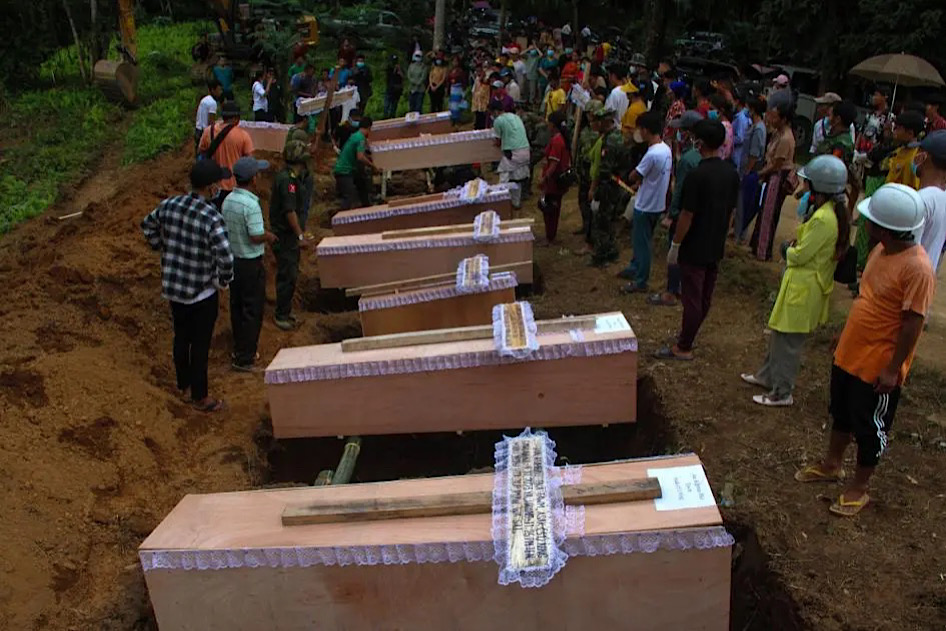Army mass killings still on the rise in the Burmese war
In the first nine months of the year at least 435 people were killed by the military. It was 113 in 2021. This is compounded by artillery strikes and air attacks against houses, schools and religious buildings, as well as massacres and arson attacks by troops in the field. The junta uses fear as a weapon. At least a thousand civilians trapped in fighting in Rakhine State.
Yangon (AsiaNews) - For the fourth year in a row - since the military returned to power following the coup in February 2021 - the number of mass killings in Myanmar has risen, with at least 435 people killed in massacres in the first nine months of this year.
The alarm is being raised by the Institute for Strategy and Policy-Myanmar in a report published in recent days, which documents cases where at least 10 or more people were killed at the same time, totalling several hundred between January and the first week of October. Added to this are systematic incidents of arrests, torture and summary justice against civilians by the army, often on specious charges of supporting the rebels.
To the tally must be added at least 25 civilians killed by the junta in Budalin in the Sagaing region between 9 and 20 this month, and another six in an air raid in the town of Myaung for a grand total of 466. According to Radio Free Asia (Rfa) reports, the number of civilians killed in mass events so far in 2024 marks the latest of an annual increase since the coup with 379 in 2023, 245 in 2022 and 113 in 2021.
Researchers explain that the number of casualties has risen with the junta's increasing use of artillery and air strikes targeting homes, schools and religious buildings, in addition to massacres and arson by troops on the ground. In one of the most recent events, on 19 October, around 100 soldiers from Battalion No.33 raided the village of Si Par in the town of Budalin, arresting and killing 22 civilians on the spot, including two elderly people.
‘The junta forces treat people like animals, not human beings,’ explains a source, who like others interviewed in the report speaks on the guarantee of anonymity to protect his safety. ‘They killed,’ he adds, ‘people of various ages, including people in their sixties and seventies.... It was so cruel that I cannot talk about it in detail'.
Kyaw Win, director of the Burma Human Rights Network, said the junta - which denies documented cases of mass killings - is using fear as a weapon in an attempt to erode public support for the armed opposition.
‘This is a strategy of the junta to threaten people... to prevent them from associating with the [rebels],’ he said. ‘It is a strategy of intimidation.’
On 16 October, Kyaw Moe Tun, Myanmar's ambassador to the UN, called on the UN Security Council to file a case against the junta with the International Criminal Court (ICC), saying it was impossible to hold the military regime accountable for its war crimes in the country's courts given the conflict situation.
Meanwhile, at least a thousand civilians are trapped in the fighting in the western state of Rakhine, while rebel groups are approaching a coup army headquarters in the town of Ann, blocking roads and with no way out for residents.
The offensive is being launched by the Arakan Army, also accused in the past of attacks and violence against the Roinghya Muslim minority, which continues to take large portions of territory away from the junta.
Most of the city's 10,000 residents fled when fighting intensified in July, but some families, totalling about a thousand people, remained because they had nowhere safe to take refuge.
The insurgents are now a couple of kilometres away from the headquarters, with the military having closed all roads, leaving the few remaining civilians in Ann with no way out.
'We have nowhere to go. Every road is closed,' says one witness, ’and the fighting is becoming extremely intense.'
11/08/2017 20:05







.png)










